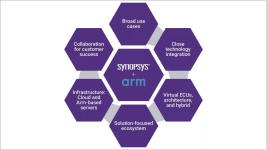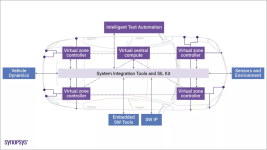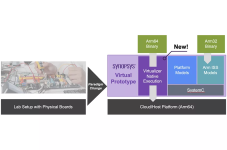Jun 04, 2025
Automakers are increasingly relying on silicon and software to meet the growing demand for smarter, safer, and AI-enabled in-car experiences. As a result, the use of chips in vehicles is surging — with the automotive semiconductor market projected to exceed $80 billion by the end of the decade.
However, current vehicle system architectures aren’t equipped to handle the real-time, multi-modal computing workloads required for these advanced in-car experiences. Additionally, while the shift to software-defined vehicles (SDVs) is expected to support significant business upside and new revenue streams, it also presents significant challenges for automakers — including rising technology costs and increased demands for engineering resources throughout the product lifecycle.
Rising software complexity, tighter development timelines, and cost pressures require automotive companies to re-engineer how they design, deploy, and maintain their system architectures. Addressing these challenges requires an agile, collaborative approach to engineering — from silicon to systems — along with trusted partners capable of delivering powerful, integrated solutions.

“The AI-defined vehicle era requires cloud-native support to scale and seamlessly deploy advanced, innovative features that drivers have come to expect,” said Suraj Gajendra, vice president of automotive products and software solutions, Automotive Line of Business, Arm. “With Arm Zena CSS and the support of partners like Synopsys, automotive developers can start designing these experiences sooner, getting to market faster without compromising on security and functional safety.”
Synopsys is a trusted partner to the global automotive ecosystem, with over 50 OEMs and Tier 1 suppliers leveraging our virtual prototyping technologies and more than 1,000 automotive virtual models developed.
Our leadership in architecture exploration, virtual prototyping, AI-driven chip design, and standards-based IP — combined with Arm’s proven, industry-optimized compute subsystems — will enable OEMs and Tier 1s to deliver differentiated SDVs on schedule while continuing to meet stringent cost requirements and safety standards.
Synopsys brings unique silicon to systems expertise — including electronics digital twin (eDT) capabilities — to the Zena CSS. Synopsys and Arm are leveraging their strengths to modernize automotive hardware/software co-design processes together in the following areas:
Synopsys hardware-assisted verification (HAV) platforms — optimized for interoperability with Zena CSS — can enable automotive companies to validate performance and power early in the SoC design and system integration process. Engineers can use our HAV technology to validate and optimize the most cost-effective way to meet target KPIs and avoid interference between systems with mixed criticality levels early on.
Automotive engineers rely on Synopsys eDT capabilities, including our Virtualizer Development Kit (VDK) for the Zena CSS, to simulate today’s interconnected domain-based and zonal E/E architectures. With these eDTs, teams can develop and test software for applications in simulated domains, reducing the need for physical hardware. This approach enables faster software delivery, helps reduce defects, and streamlines hardware/software co-design processes.
Synopsys also works closely with semiconductor and automotive technology ecosystem partners to provide pre-integrated solutions for seamless silicon and software design, test, and deployment workflows. Examples include our collaboration with Vector Informatik to advance the SIL Kit open-source library, as well as with Continental, Elektrobit, IPG Automotive, and others to integrate virtual prototyping capabilities in their solutions.

Virtualizer Native Execution significantly speeds up the performance of virtual prototypes on Arm hardware, thereby expediting software development, debugging, and testing processes. Virtualizer Native Execution support of the Zena CSS empowers customers to take full advantage of Arm from cloud to car.

To further highlight the benefits of Arm cloud-to-car parity, Synopsys and Arm are early collaborators enabling the shift to scalable, cloud-native software development. Together, we recently demonstrated a SOAFEE standardized middleware and orchestration layer for SDV workloads running on Synopsys VDKs. This illustrates how cloud-to-car flows ease automotive software development and maintenance on Arm hardware in the cloud, helping reduce engineering time, cost, and complexity.
Our comprehensive automotive design solutions deliver complex functional safety analysis and implementation capabilities while our HAV solutions accelerate software bring-up and hardware/software validation across the automotive supply chain.
In addition, our broad portfolio of ASIL-compliant automotive-grade Interface, Security, and Foundation IP complements Arm Automotive Enhanced (AE) IP and the Zena CSS to provide customers with flexibility and interoperability for their automotive SoC and multi-die designs.
Coupled with our Silicon Lifecycle Management IP, OEMs can assess real-time silicon health metrics such as voltage, temperature, and margins. They can also monitor silicon aging and reliability across vehicles and fleets to provide predictive maintenance, extend the lifecycle of automotive systems, and reduce costs.
Leveraging optimized solutions from Synopsys, OEMs and Tier 1s can ease development complexity and costs, while also enhancing product differentiation throughout the lifecycle of vehicles.
With this foundation in place, the SDV system design continuum can offer even more opportunities for engineering productivity — as well as new ways to deliver value to automotive customers.
Link to Press Release
Automakers are increasingly relying on silicon and software to meet the growing demand for smarter, safer, and AI-enabled in-car experiences. As a result, the use of chips in vehicles is surging — with the automotive semiconductor market projected to exceed $80 billion by the end of the decade.
However, current vehicle system architectures aren’t equipped to handle the real-time, multi-modal computing workloads required for these advanced in-car experiences. Additionally, while the shift to software-defined vehicles (SDVs) is expected to support significant business upside and new revenue streams, it also presents significant challenges for automakers — including rising technology costs and increased demands for engineering resources throughout the product lifecycle.
Rising software complexity, tighter development timelines, and cost pressures require automotive companies to re-engineer how they design, deploy, and maintain their system architectures. Addressing these challenges requires an agile, collaborative approach to engineering — from silicon to systems — along with trusted partners capable of delivering powerful, integrated solutions.

Synopsys and Arm: Reducing complexity and accelerating SDV system design
Synopsys and Arm have collaborated closely for three decades, helping customers develop specialized silicon more cost-effectively, with reduced risk, and with faster time to market. Synopsys joined the Arm Total Design ecosystem when it launched in 2023, providing tools that help support the Arm Neoverse V3 platform and Arm Neoverse Compute Subsystems (CSS). Today, we’re expanding our extensive co-optimization efforts to include Arm’s first-generation CSS for automotive, Arm Zena CSS.“The AI-defined vehicle era requires cloud-native support to scale and seamlessly deploy advanced, innovative features that drivers have come to expect,” said Suraj Gajendra, vice president of automotive products and software solutions, Automotive Line of Business, Arm. “With Arm Zena CSS and the support of partners like Synopsys, automotive developers can start designing these experiences sooner, getting to market faster without compromising on security and functional safety.”
Synopsys is a trusted partner to the global automotive ecosystem, with over 50 OEMs and Tier 1 suppliers leveraging our virtual prototyping technologies and more than 1,000 automotive virtual models developed.
Our leadership in architecture exploration, virtual prototyping, AI-driven chip design, and standards-based IP — combined with Arm’s proven, industry-optimized compute subsystems — will enable OEMs and Tier 1s to deliver differentiated SDVs on schedule while continuing to meet stringent cost requirements and safety standards.
Synopsys brings unique silicon to systems expertise — including electronics digital twin (eDT) capabilities — to the Zena CSS. Synopsys and Arm are leveraging their strengths to modernize automotive hardware/software co-design processes together in the following areas:
Holistic SDV system management with electronics digital twins (eDTs)
Accurately predicting performance early in the process is essential for speeding up the development of automotive SoCs. Using Synopsys Platform Architect, automotive hardware and software architects can use early models to explore and predict KPIs such as latency, bandwidth, contention, and utilization of their application workloads executing on specific Zena CSS configurations.Synopsys hardware-assisted verification (HAV) platforms — optimized for interoperability with Zena CSS — can enable automotive companies to validate performance and power early in the SoC design and system integration process. Engineers can use our HAV technology to validate and optimize the most cost-effective way to meet target KPIs and avoid interference between systems with mixed criticality levels early on.
Automotive engineers rely on Synopsys eDT capabilities, including our Virtualizer Development Kit (VDK) for the Zena CSS, to simulate today’s interconnected domain-based and zonal E/E architectures. With these eDTs, teams can develop and test software for applications in simulated domains, reducing the need for physical hardware. This approach enables faster software delivery, helps reduce defects, and streamlines hardware/software co-design processes.
Synopsys also works closely with semiconductor and automotive technology ecosystem partners to provide pre-integrated solutions for seamless silicon and software design, test, and deployment workflows. Examples include our collaboration with Vector Informatik to advance the SIL Kit open-source library, as well as with Continental, Elektrobit, IPG Automotive, and others to integrate virtual prototyping capabilities in their solutions.

Accelerated cloud-to-car software testing and deployment
Recently, we extended the Synopsys Virtualizer tool suite to the Arm ecosystem with Virtualizer Native Execution on Arm-based hardware. This allows automotive applications to be designed, executed, and tested directly on Arm server CPUs in the cloud without requiring emulation. This means developers can run workloads at or near real-time speeds, roughly 100x faster than traditional instruction-set simulators.Virtualizer Native Execution significantly speeds up the performance of virtual prototypes on Arm hardware, thereby expediting software development, debugging, and testing processes. Virtualizer Native Execution support of the Zena CSS empowers customers to take full advantage of Arm from cloud to car.

To further highlight the benefits of Arm cloud-to-car parity, Synopsys and Arm are early collaborators enabling the shift to scalable, cloud-native software development. Together, we recently demonstrated a SOAFEE standardized middleware and orchestration layer for SDV workloads running on Synopsys VDKs. This illustrates how cloud-to-car flows ease automotive software development and maintenance on Arm hardware in the cloud, helping reduce engineering time, cost, and complexity.
AI-driven EDA solutions and automotive-grade IP support functional safety and cybersecurity compliance
Our industry-leading semiconductor design solutions help automotive hardware, software, and systems engineers comply with functional safety (FuSa) and cybersecurity standards knowing that the tools used to develop automotive components must also be ISO 26262 and ISO/SAE 21434 compliant.Our comprehensive automotive design solutions deliver complex functional safety analysis and implementation capabilities while our HAV solutions accelerate software bring-up and hardware/software validation across the automotive supply chain.
In addition, our broad portfolio of ASIL-compliant automotive-grade Interface, Security, and Foundation IP complements Arm Automotive Enhanced (AE) IP and the Zena CSS to provide customers with flexibility and interoperability for their automotive SoC and multi-die designs.
Coupled with our Silicon Lifecycle Management IP, OEMs can assess real-time silicon health metrics such as voltage, temperature, and margins. They can also monitor silicon aging and reliability across vehicles and fleets to provide predictive maintenance, extend the lifecycle of automotive systems, and reduce costs.
Unlocking new opportunities on the SDV continuum
While the industry’s transformation to SDVs requires automotive companies to re-engineer how engineering is done from silicon to systems — it also offers significant opportunities.Leveraging optimized solutions from Synopsys, OEMs and Tier 1s can ease development complexity and costs, while also enhancing product differentiation throughout the lifecycle of vehicles.
With this foundation in place, the SDV system design continuum can offer even more opportunities for engineering productivity — as well as new ways to deliver value to automotive customers.
Link to Press Release
